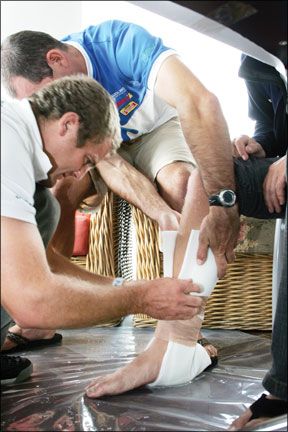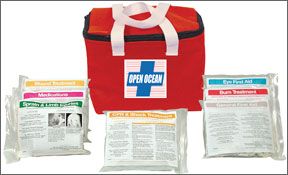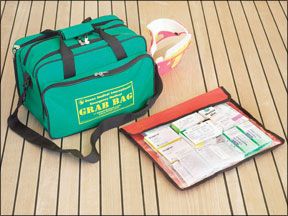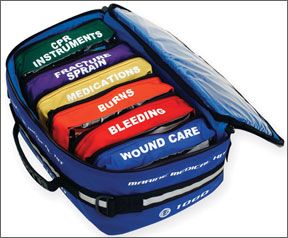
In this age of cell phones and GPS navigation, it is easy to forget that a short coastal cruise, whether its hours or days, is a wilderness experience. Whether youre exploring Down East Maine or Washingtons San Juan Islands, you will be venturing, to some extent “into the wild.” If someone on your boat should get sick or injured, even in a short coastal hop, it could be several hours before a qualified medical professional will be able to treat the person. This is something to keep in mind as Practical Sailor moves into the more advanced kits well be covering in this series on ready-made medical kits for marine use. (The first article in this series, “Daysailer and Dinghy Medical Kits,” appeared in the April 2008 issue.)
WHAT WE TESTED
For this article, Practical Sailor sought medical kits suitable for boats with one to four crew, where help may not be available for up to 12 hours. As with all of the medical kits involved in the evaluation, we set specific criteria, including of list of minimum supplies for such a kit. (See “How We Tested”) Such a “Coastal Cruiser” kit would be a good choice for a family of four getting away for a long weekend, or perhaps longer, but still remaining relatively close to the coast and populated areas. Practical Sailor set a target maximum price of $300 for this group, and all but one of the kits reviewed fell within that limit. Practical Sailor testers thoroughly examined the contents as well as their containers, and evaluated their instruction manuals.
Crew on boats venturing farther from shore or sailing in more remote areas have a greater risk of injury and illness. Waters farther from shore will be more open, and exposed to waves with a longer fetch and winds at higher speeds. More time spent on deck is apt to increase the incidence of dehydration, headaches, nausea, and sunburn. More traumatic injuries such as cuts, sprains, and severe injuries will occur because the boats are apt to be in less stable sea conditions. Seasickness will also be a more significant problem.
A coastal cruiser medical kit will be called upon to sustain crewmembers with a wider variety of ailments for a longer time than those daysailer kits reviewed in the April article. So not only do these kits require items that werent in the daysailer kits, they need more of the core items like bandages and basic medications. A hypothermic thermometer (with a range for measuring low body temperature), and a space blanket are among those items that werent in our daysailer kit but should be in the coastal cruiser kit. Several medications have been added to combat seasickness, sunburn, nausea, pain, hypoglycemia, hypothermia, and other conditions that can arise at sea. The table reflects the minimum Practical Sailor recommends for such a kit. The list is by no means definitive, and we encourage sailors to add to it as they see fit for their own circumstances.
Fieldtex Excursion
Fieldtex markets the Excursion kit for trips ranging from a weekend to a week, with contents included for a crew of up to eight people. The company claims that the contents should suffice in situations where medical assistance is up to 24 hours away.

This is an impressive product. The quality of the contents is very good, and the same can be said for the arrangement of the five modules and the waterproof instructions. The modules are color-coded to correspond with sections within the manual. Testers particularly liked the hard container, which was ranked Excellent for water integrity, shock resistance, and durability. Its bright yellow color makes for quick identification.
Impressive as it may be at first glance, the Excursion kits contents were the most lacking when compared against our list of must-haves. While many essentials are supplied, the kit does not include several items we consider mandatory for Group II kits: anti-seasickness medications, sterile gloves, and elastic adhesive bandages. Additionally, very few medications are included in the kit, but it does contain a separate module with space for personal medications to be added. The Excursion kit retails for $300.
Bottom Line: A great container with good quality contents. If you go this route, youll want to supplement it with more of the recommended medications and supplies on our list.
Orion Open Ocean
The Open Ocean medical kit from Orion Safety Products of Peru, Ind., is one of six marine first-aid kits that this company sells. Other than what can be inferred from the products name, the company makes no claim about which circumstances this kit is suited for, nor the number of crew it can service. After evaluating its contents, Practical Sailors tester decided it came closest to meeting the criteria for Group II, coastal cruising.
The kit comes in a double-zippered, PVC-coated nylon bag containing seven different modules, which the company claims are suitable for handling “most onboard emergencies.” Each module is contained in a re-sealable, zip-locking, waterproof bag. The company claims that all its bandages are of premium fabric quality and resistant to water.
Our tester noted that the Open Oceans soft, pliant container offers minimal shock resistance and water integrity. And, only the most rudimentary instructions are included, written on the backs of the modules; not in book form.
Bottom Line: This kit lacks too many items essential in this class: sterile syringe, thermometers, and splints, to name a few. Even at a bargain price of $77, its inferior contents, information manual, and medications leave it far short of the others in this group.
OMI Class C Day-Tripper
The label on the green nylon satchel that encloses Ocean Medical Internationals Class C Day-Tripper reads “Grab Bag.” The company markets this kit as suitable for a crew of up to 10 and advertises that it is designed “for use on smaller boats that do not go far from shore … and/or travel up to 60 nautical miles offshore or three hours from medical care.”

That description would seemingly put the Class C Day-Tripper within our coastal cruiser group, but its price definitely sets this product apart: $1,500.
To better understand this discrepancy, Practical Sailor contacted Rebecca Castellanos, who represents OMI in the U.S. She was emphatic that OMIs Class C kits are quite different from the others we evaluated in this group. She elaborated in an e-mail: “All of our kits meet or exceed the standards set by the MCA/STCW 95 requirements (standards established by the United Kingdoms Maritime and Coast Guard Agency and the International Maritime Organizations Standards of Training, Certification and Watchkeeping).” Castellanos claimed that the kits marketed to most small, privately owned sailboats don’t meet these standards. In fact, she told us, there are only four companies worldwide that provide medical kits with comparable contents to OMIs kits, and those products are priced similarly to OMIs.
Castellanos said that OMI does offer other kits designed for smaller boats and long-distance cruisers, which contain many prescription medications (hence the hefty prices), and these kits also meet the minimum requirements for MCA/STCW certification.
Admittedly, this Class C Day-Tripper is an apple among oranges in several regards. The Medical Instructions Manual, Assessment and Stabilization guide and Medical Reference Manual offer first-class instructions. And the contents are made up of numerous modules with items that well surpass our Group II standards, such as an automatic blood pressure machine, an immobilization neck collar, a resuscitation mask, and an airway suction device.
Our tester found that the components are of the highest quality, and they stack up well to our group standard in quantity and variety of items included. The Day-Tripper contains the most medications of any kit examined in this category. It is unquestionably the most suitable for crews with more senior members as its medications and supplies include several items suitable in treating conditions such as breathlessness, convulsions, angina, cardiac arrest, and ventricular fibrillation.
The container itself is sturdy and provides good shock resistance and durability. It is water-resistant, and limits water ingress, and the modules within are packaged in clear plastic packets that close with a Velcro strip along the top, so no aspect is entirely waterproof. For an additional fee, the company also offers emergency medical consultation services-what it calls First Call-with professionals available 24-7.
Bottom Line: A very comprehensive and very expensive kit with an overload of medications and emergency medical devices. This kit contains far more than what the coastal cruiser will need.
Adventure medical Marine 1000
According to its manufacturer, Adventure Medical, “The Marine 1000 is designed to provide the medical supplies you need for coastal cruising when professional medical care can be reached within 12-24 hours.” It is recommended for vessels with crews of 10 or fewer people.

Practical Sailor found the quality of the contents to be high. All materials and medicines are arranged into six separate modules that keep the kit neat and the items easy to locate due to the modules clear vinyl windows. There are Easy Care cards with instructions in each module, but the kit also comes with a copy of “A Comprehensive Guide to Marine and Travel Medicine” by Dr. Eric A. Weiss and Dr. Michael Jacobs. (Jacobs is the director of Vineyard Medical Services on Marthas Vineyard and holds a U.S. Coast Guard 100-ton license. Weiss is the co-developer of the Easy Care system.) This kit contains a strong assortment of items. Compared with Practical Sailors Group II standards, it lacks only sterile gloves and a space blanket.
The buoyant, padded container ranked high in organization, water integrity, shock resistance, and durability. It also comes with a reflective strip around the exterior so that it can be more easily found in darkness or low-light conditions. The Marine 1000 kit retails for $295.
Bottom Line: This is a comprehensive medical kit that offers most items necessary for a 10-person crew to attend to injured members for up to 24 hours. Its Practical Sailors Best Choice among Group II contenders.
Conclusion
This group revealed some distinctions in philosophy between the suppliers, as evidenced by the focus of items in the kits. Ocean Medical International specializes in kits for large vessels with many people aboard. This is reflected in the supply of medications in the Class C Day-Tripper kit, which far exceed our Group II minimum standards. The other companies also produce kits for non-sailing pursuits, and their Group II offerings are more streamlined and focused than the Day-Tripper from OMI.
The contents of all four kits were of very good quality, and each manufacturer arranges the contents into distinct modules. None of these kits was lacking-except the Open Ocean kit in quantity of contents and quality of its instruction manual-but we did find advantages and disadvantages to each. The Day-Tripper features the greatest assortment of supplies and medications, but at more than three times the cost of the others. The Fieldtex Excursion ranks lowest in medications, but the hard container is the finest available. Adventure Medicals 1000 kit is well-stocked in supplies and medications. Its written instructions ranked high, and the case is sturdy and protects the contents well, ranking behind only the Excursions hard case.
The differences in these kits render them difficult to compare because their distinct advantages make them more suitable for different kinds of vessels. The Excursion would be ideal for crews that not only sail, but customarily take the kit with them on shore for expeditions that would subject the kit to harsh conditions. The OMI Day-Tripper is best for vessels with older crews, or those with pre-existing medical conditions. Adventure Medicals Marine 1000 is strong in all categories, and is suitable for virtually any crew.
When the quality, quantity, and assortment of contents, written instructions, container, and price are all considered, the Marine 1000 from Adventure Medical is the kit that we would recommend for most crews. Our tester particularly liked the kits neatness and organization. This helps keep the nearly complete contents of the Marine 1000 readily identifiable and accessible. While we would be more comfortable with a red or orange container to better identify this as a medical kit, we applaud its use of reflective material to make it easier to locate at night. The Marine 1000 is the overall top choice for a coastal cruising boat.


































